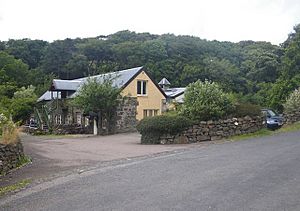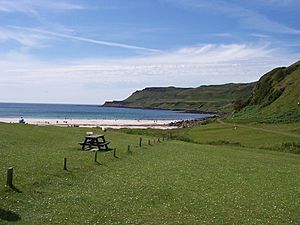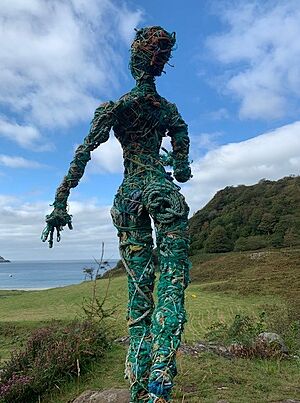Calgary, Mull facts for kids
Quick facts for kids Calgary
|
|
|---|---|
 Tearoom near the road in Calgary |
|
| OS grid reference | NM377516 |
| Civil parish |
|
| Council area | |
| Lieutenancy area | |
| Country | Scotland |
| Sovereign state | United Kingdom |
| Post town | ISLE OF MULL |
| Postcode district | PA75 |
| Dialling code | 01688 |
| Police | Strathclyde |
| Fire | Strathclyde |
| Ambulance | Scottish |
| EU Parliament | Scotland |
| UK Parliament |
|
| Scottish Parliament | |
Calgary is a small village, also called a hamlet, located on the northwest coast of the Isle of Mull. This beautiful island is in Argyll and Bute, Scotland, which is part of the United Kingdom. Calgary is famous because it gave its name to a much larger city: Calgary, Alberta, in Canada.
Contents
Exploring Calgary's Location
Calgary is found along the B8073 road. It's about 5 miles (8 km) west of Dervaig. It's also about 12 miles (19 km) from Tobermory, which is the main town on the island. The village itself is a small group of houses. These homes are spread out near a hotel and the Calgary Farmhouse.
Calgary Bay and Its Features
Calgary sits at the eastern end of Calgary Bay. Low, partly wooded hills surround the area. Between the land and the beach, there's a wide area of special grassy meadow. This meadow grows on sandy soil and is called machair. When the tide goes out, a small river winds its way across the sands. The beach has a small car park and public toilets. You can also do short-stay wild camping in tents in a special area. Calgary Castle looks out over the bay, adding to the scenic view.
A Glimpse into Calgary's Past
The name "Calgary" comes from the Gaelic words Cala ghearraidh. This means "Beach of the meadow" or "Beach of the pasture." "Cala" specifically means a hard, sandy beach where boats can land. This makes sense for Calgary's location. However, some people think the name might come from Old Norse words. The Vikings, who lived in the Inner Hebrides, might have used kald (cold) and gart (garden).
The Old Pier and Deserted Village
A small stone pier was built near the bay a long time ago. It was first used for "Clyde puffers." These were small steam-powered cargo boats that brought coal to the Mornish Estate. The pier was also used to move sheep to and from grazing areas on the Treshnish Isles.
Just up the hill from the pier, you can find the deserted village of Inivea. All that's left are stone ruins without roofs. This village is a sad reminder of the Highland clearances. These clearances were a time when many people were forced to leave their homes in the Scottish Highlands. The actor David Tennant, who played the Tenth Doctor in Doctor Who, traced his family back to this village on the TV show Who Do You Think You Are?
You can still see the remains of about 24 buildings in Inivea. Many of their walls are still standing. These buildings included houses and barns. There were also enclosed areas that were probably used as small vegetable gardens, called kailyards. A flat area to the north, higher than the houses, shows signs of old farming methods. You can see patterns in the ground called "rig and furrow." There's also a drying kiln, which was used to dry crops. On a rocky hill above the houses, you can find the remains of an old fort, called a dun. Many of its stones were used to build the houses in the village.
Calgary House and its Canadian Connection
On the east side of Calgary Bay is Calgary House. It's now known as Calgary Castle. This building was built in 1817, expanding an older house owned by the local Laird (landowner). A very important guest once stayed here: Colonel James Macleod. He was a commissioner of the North-West Mounted Police in Canada.
In 1876, shortly after returning to Canada, Colonel Macleod suggested naming a new fort after Calgary House. This fort was called Fort Calgary. Over time, this fort grew into the large city of Calgary, Alberta. Today, Calgary, Alberta, is a huge city with over 1.4 million people. The wider area around it, called the Calgary Metropolitan Region, has a population of 1.5 million. It's amazing how a small Scottish hamlet gave its name to such a big Canadian city!




